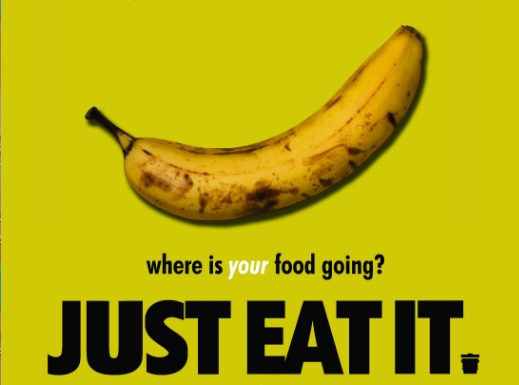I recently watched a fantastic, enlightening documentary called Just Eat It.
It’s about a North-American couple who spent six months living off only food that has been thrown away or discarded. The documentary is funny and entertaining, yet ultimately it brings powerful light to one of the most critical issues on our planet: the gross amount of food being wasted.
One might think that maybe the couple ended up rummaging through garbage bins salvaging food remains, or perhaps scraping the plates of other people’s decimated leftovers. The reality? The couple ends up obtaining mass quantities—more than the two of them can even manage to eat themselves—of perfectly good, quality food that large food wholesalers have chosen to dispose of due to a variety of policy-related “reasons” (the nutritional information not being printed in French was one of the reasons why a large quantity of chocolate was thrown out).
I have always been playfully regarded as “obsessive” about food waste.
Someone of the North American culture would probably call my food consuming habits “extreme.” My family refers to me as “the girl who will eat anything” due to my habit of not allowing them to throw away any leftovers. You know, those last (possibly slightly shrunken) apples or container of pasta that has been sitting in the fridge for extended periods of time. (And in my defence, the apple is still perfectly edible—there is no rot or safety hazard whatsoever in eating it—it simply isn’t in the “prime” condition that most food consumers have come to expect.)
When I go over to someone’s house for dinner and they put a freshly cooked meal on the table I struggle with the internal urge to rather go to their kitchen and have all the leftovers in their fridge instead, for fear they won’t actually get eaten. I don’t like going to restaurants anymore because of the amount of food left on people’s plates being carried off by the waiter.
My ex described me as being “the waste police” when I would make him give me the bread or pizza crusts left on his plate.
Food waste paranoia, you might even call it. The documentary describes this attitude toward food consumption as the “World War II” mindset. They illustrate someone having such mindset as one who will re-use their tea bag for many days, or who will literally put a couple bites worth of food in a container in the fridge for later—and actually eat it. (And yes, I confess I have done both these things.)
Although I am fortunate enough to live in a time and part of the world where high quality food is abundant, I apparently still adopt this outdated mindset. For whatever reason, I seem to naturally and inherently possess the mindset of extreme food scarcity, even when we don’t live in an era of food scarcity any longer.
I confess that this documentary made me feel like slightly less of cultural misfit.
I am by no means suggesting that we all eat our partner’s leftover bread crusts.
Rather, I would like to bring light to the issue and draw attention to the widely practiced, and accepted, food waste phenomenon of our time.
After watching the documentary, I learned of some of the stunning figures on food waste that simply cannot be ignored:
An astounding one third of food fit for human consumption is lost or wasted between the farm and the fork. Just think about that for a moment.
While nearly 800 million people—one in nine globally—are undernourished, more than a billion tons of food never make it to the table. The inefficiencies in our global food system have mass impacts for nutrition, health and the environment.
That’s not even taking in to account the 40-70 percent of all fruits and vegetables that are immediately rejected immediately upon harvest, as the they do not meet the size, shape or colour appearance requirements of the large food corporation industries that they will be sold to, despite nothing being wrong with the actual produce.
So basically, that cauliflower that is too large—or that banana that doesn’t curve to the particular curvature requirements of said large food corporation—is thrown out. Not sellable somehow equates to inconsumable.
In the U.S. alone, roughly 40 percent of the food supply chain is wasted, equalling more than 20 pounds of food per person per month. Organic waste is also the second highest component of landfills in America and is the largest source of methane emissions.
Every year, consumers in industrialized countries waste almost as much food as the entire net food production of sub-Saharan Africa—about 230 million tons!
If we were to look at the food waste problem on a global scale, we would learn that about a third of all food produced worldwide—worth over $1 trillion—gets lost or wasted in food production and consumption systems.
In a world full of hunger, the numbers were more than just shocking: they are environmentally and morally outrageous. Staggering.
Wasting food in North America has become more than a cultural norm, it is often condoned. It is often seen as “impolite” at restaurants to completely finish all the food on your plate. (What a pig! I can’t believe they just polished off their entire plate like that!) Or, if one is full, it is viewed as tacky or cheap to ask to have the food packed away to take home.
In a time and era where food is abundant and easily sourced for many, somehow throwing away perfectly good food—a resource—became okay.
I encourage and challenge us all to become more mindful food consumers.
This doesn’t require a complete revolution in the way we treat food; rather it’s just tweaking it slightly, and usually in delicious ways.
Here are seven simple ways we can all help reduce the amount of food wasted:
1. Become a more mindful eater. Request smaller portions and become a leftover guru.
2. Think. Be a smart shopper and think about what you are buying and when it will be eaten. Wasting food is often a subconscious act—become aware of how much food you throw away.
3. Plan meals and use shopping lists (and stick to the list!)
4. Buy “funny” looking produce. It tastes just as good and saves food that might be otherwise wasted simply because it’ shape and colour are not “right.”
5. Understand food labels, and know that best before dates are not expiry dates or ultimatums—rather they are only an indicator of suggested peak freshness, not safety.
6. When you get home, organize newest groceries at the back, oldest at the front. Even have an “Eat Me ASAP!” section right at the front which will help prioritize perishables.
7. If the clock is ticking, freeze it, can it, dry it or dehydrate it. Get creative with soups, stews and smoothies and ‘use it up’ options as well.
Let’s becoming more mindful of food waste and the effect it’s having on the planet. Save your food, save your money and save the environment.
Be mindful of the resources we are simply throwing away and become a conscious food consumer.
Author: Michelle Amanda Jung
Image: Youtube
Editor: Sara Kärpänen


 Share on bsky
Share on bsky





Read 0 comments and reply